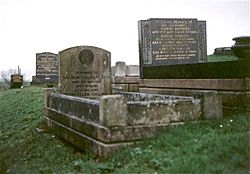John Collins (VC) facts for kids
Quick facts for kids
John Collins
|
|
|---|---|

John Collins grave, Pant Cemetery
|
|
| Born | 10 September 1880 West Hatch, Somerset |
| Died | 3 September 1951 (aged 70) Merthyr Tydfil, Mid Glamorgan |
| Buried |
Pant Cemetery, Merthyr Tydfil
|
| Allegiance | |
| Service/ |
|
| Rank | Sergeant |
| Unit | Royal Welch Fusiliers |
| Battles/wars | Second Boer War First World War |
| Awards | Victoria Cross Distinguished Conduct Medal Mentioned in dispatches |
John Collins was a brave soldier who received the Victoria Cross (VC) and the Distinguished Conduct Medal (DCM). The Victoria Cross is the highest award given for amazing bravery when facing the enemy. It is given to soldiers from the United Kingdom and Commonwealth countries.
John Collins was born on September 10, 1880. His hometown was West Hatch in Somerset, England. When he was 10 years old, his family moved to Merthyr Tydfil in South Wales.
Contents
Joining the Army
John Collins joined the Royal Horse Artillery in 1895. This was when he was just 15 years old. He served in South Africa during the Boer War. He was one of the first soldiers to enter Ladysmith when it was rescued. He also spent time serving in India.
It is thought that he left the Army in 1907. After leaving, he worked as a coal miner at the Bedlinog Colliery. Sadly, many of his old army records were lost during the London Blitz in 1940.
Serving in World War I
In 1915, John Collins joined a new group called the Welsh Horse Yeomanry. This group was sent to Gallipoli, a place where a big battle was happening. His unit worked on digging tunnels and trenches. They were among the last British troops to leave Gallipoli.
After Gallipoli, the Welsh Horse went to Egypt. They helped guard the Libyan desert. In January 1917, his unit joined with another. They became the 25th Battalion of The Royal Welch Fusiliers. This was part of the British Army.
By October 1917, John Collins was 37 years old. He was an acting corporal, which is a junior leader. His battalion was getting ready for a big attack.
A Heroic Act: The Victoria Cross
On October 31, 1917, a major battle took place. It was called the Battle of Beersheba in Palestine. John Collins's battalion was lying in the open. They were under heavy fire from shells and machine guns. Many soldiers were getting hurt.
Corporal Collins showed incredible bravery. He went out many times into the dangerous fire. He brought back many wounded soldiers to safety. His actions saved many lives that day.
Later in the battle, he continued to be a hero. He helped to gather and lead his fellow soldiers. He led the final attack with great skill. Even with heavy enemy fire and barbed wire, he pushed forward. He used his bayonet against 15 enemy soldiers. With a machine gun team, he went past their target. He helped his unit get organized and hold their new position. He did this even though he was alone and being shot at by snipers.
For his amazing bravery, John Collins was awarded the Victoria Cross. He later became a sergeant.
Later Life and Legacy
King George V presented John Collins with his Victoria Cross. This special ceremony took place at Buckingham Palace on June 1, 1918.
Today, you can see John Collins's Victoria Cross. It is on display at the Royal Welch Fusiliers Museum. This museum is inside Caernarfon Castle in Wales. There is also a special plaque there to remember him. A painting of John Collins is also on display at Cyfarthfa Castle Museum & Art Gallery.

